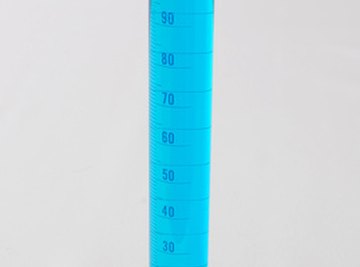
Density refers to the ratio of a substance’s mass to its volume. Density is not measured directly; it requires two separate measurements of mass and volume. Scientists and engineers express density in metric units of grams per milliliter (g/mL). The measurements, however, can be taken in English units and are easily converted.
Density is temperature-dependent. The volumes of liquids expand with increasing temperature, and thus the densities of liquids (and most solids) tend to decrease with increasing temperature. As a consequence, most chemical reference books that give tabulated density values will state the temperature at which the measurement was taken (usually room temperature, 25 degrees Celsius).
- Balance or scale with accuracy to 1 gram (0.1 ounces)
- Graduated cylinder or 8-oz. measuring cup
- Calculator
If a kitchen measuring cup is used to measure the oil's volume, it should never again be brought into contact with food.
Acquire a graduated cylinder and balance similar to those used in chemistry labs. An 8-oz. kitchen measuring cup may be substituted, although this will be less accurate. If a laboratory balance is not available, a small postal scale may be used.
Tare the balance or scale (so it reads zero), then weigh the empty cylinder or measuring cup. Write down this weight for future reference.
Fill the cylinder or measuring cup about half full with the oil and read the volume from the graduated markings on the side of the container. If using a graduated cylinder, the oil will form a U-shape at its surface. This is called a “meniscus” and the correct reading should be taken from the bottom of the U. Write down this volume for future reference.
Calculate the weight of the oil in the container by subtracting the weight of the empty container from the weight of the container containing the liquid:
X (weight of oil) = A (weight of container with oil) – B (weight of empty container).
Convert these values to more convenient units if desired. If the volume was measured in fluid ounces, convert to milliliters (mL) by multiplying by 30. Thus, 2.5 oz. would be 2.5 x 30 = 75 mL.
If the weight of the oil was measured in ounces, convert this to grams by multiplying by 28. Thus, 2.0 ounces would be 2.0 x 28 = 56 grams.
Calculate density by dividing the mass in grams by the volume in milliliters. Using the values from step 5,
56 grams / 75 mL = 0.75 g/mL.
Things You'll Need
Warnings
References
Warnings
- If a kitchen measuring cup is used to measure the oil's volume, it should never again be brought into contact with food.
Photo Credits
cylinder image by Hubert from Fotolia.com
